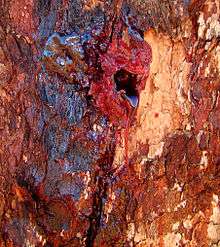Corymbia opaca
| Desert Bloodwood | |
|---|---|
 | |
| Bloodwood tree, Central Australia | |
| Scientific classification | |
| Kingdom: | Plantae |
| (unranked): | Angiosperms |
| (unranked): | Eudicots |
| (unranked): | Rosids |
| Order: | Myrtales |
| Family: | Myrtaceae |
| Genus: | Corymbia |
| Species: | C. opaca |
| Binomial name | |
| Corymbia opaca | |
| Synonyms | |
| |
Corymbia opaca, also known as the Desert Bloodwood, is a tree native to Australia. The tree is most well known for the distinctive red kino that it exudes. Australian Aboriginal people collect bush coconuts (a type of bush tucker) from the tree, which are produced by an insect in gall.[1]
Classification
C. opaca was previously considered to be part of C. terminalis, but was split off along with some 10 other species in 1995.[2][3] This split remains controversial, with some authors and herbaria accepting C. opaca as a distinct species and others considering it to be inseparable from C. terminalis.[4] To the extent that the species can be reliably differentiated, C. terminalis has thinner leaves larger buds and fruit and thicker pedicels than C. opaca.[3]
Region
The tree grows in the desert climate of Australia's Northern Territory, Central Australia (particularly around Alice Springs) as well as Western Australia and South Australia.[1] It is found in a variety of habitats, commonly on sandy soils in alluvial areas and lower hillslopes.[3][5]
Description
The desert bloodwood has a rough bark, which when penetrated oozes a thick red kino. Typical of desert flora, the tree has tough leathery leaves. Flowers appear during cooler months, producing pollen and nectar which is harvested by a variety of wildlife. The hard fruit produced by the tree is the gumnut. The tree generally grows 8 – 10 metres (30 feet) in height.[1]

Use in bush medicine
Occasionally a bloodwood tree will shed a piece of bark, hence opening a "wound" through which a blood-like kino will flow. The sap flows until it crystallises, covering up the hole in the bark. Australian Aboriginals collect this substance as bush medicine. They apply the sticky gum directly to sores or cuts and it works as an antiseptic. If the sap is in a dried form, it can be crushed into powder and boiled in water to use as an antiseptic wash.[6]
Another use of the bloodwood sap by Aboriginal people is to tan "kangaroo-skin waterbags".[1]
Roots
The roots of the bloodwood tree store water. Aboriginal peoples would dig up the roots and drain the water into a container.[7]
References
- 1 2 3 4 "Nature Notes - Desert Bloodwood Tree". Alice Springs Desert Park.
- ↑ Hill, K.D. & Johnson, L.A.S. (1995) Systematic studies in the eucalypts. 7. A revision of the bloodwoods, genus Corymbia (Myrtaceae). Telopea 6: 185–504.
- 1 2 3 Philip Moore 2005 “A Guide to Plants of Inland Australia” Reed New Holland
- ↑ http://www.anbg.gov.au/cpbr/cd-keys/euclid3/euclidsample/html/Corymbia_terminalis.htm
- ↑ Purdie. J., Materne. C., Bubb. A, 2008 “A Field Guide to Plants of the Barkly Region of the Northern Territory” Barkly Landcare and Conservation Association Incorporated
- ↑ "Desert Bush Medicine". Alice Springs Desert Park.
- ↑ "Kwatye — water". Alice Springs Desert Park.